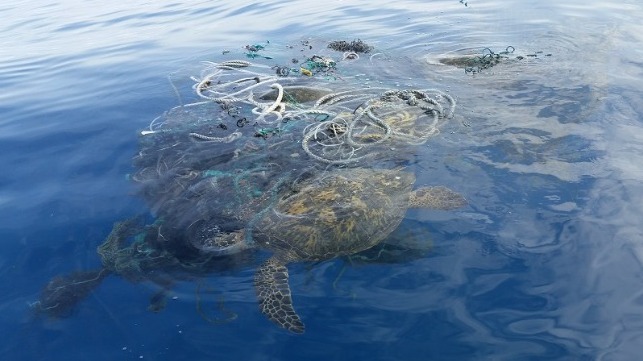Researchers Combat Ghost Fishing With New Materials

[By Christina Benjaminsen]
All over the world, fishing nets are one of the most widely used items of fishing gear.
“These nets are very important to the global fishing industry because they are easy to use, have high catch efficiency and represent a low upfront investment for fishing operators”, says researcher at SINTEF, Christian Karl.
“Sadly, large numbers of nets are lost at sea each year, and lost fishing gear has many negative impacts on both life in the sea and fisheries management. Because the nets are made of synthetic materials such as nylon, which is very resilient and durable, lost and discarded fishing gear continues to catch fish for many years after it enters the sea”, he says.
This phenomenon is called ‘ghost fishing’. A new centre for research-based innovation (SFI) called DSOLVE is being established at the University of Tromsø, and Christian Karl and his colleagues at SINTEF will be looking into how the plastic used to manufacture fishing gear can be made less harmful to the environment.
Resolving the problems of our existing degradable nets
Currently, nets that are designed to be degradable are more expensive and less efficient to use than traditional nylon nets. Issues are also being raised about how degradable the materials used to make these nets really are, and whether in fact they represent a truly ecologically sustainable solution.
In the past, researchers have conducted a number of small-scale tests, which have demonstrated that it is essential to combine both research and industrial development in order to enable the commercialisation and use of biodegradable plastics in the marine-based industries.
Researchers from SINTEF will be looking in detail at how new plastic materials break down in the natural environment, and what environmental impacts they have compared with traditional materials.
SINTEF Ocean and SINTEF Industry have been working to address similar problems in the past. Changes in the mechanical properties of conventional nylon nets and a new, and supposedly biodegradable, material have previously been studied over a period of three years. Scientists found that the strength of the new nets was not only weaker than the average for nylon net materials, but that the nets themselves were also less effective in terms of catching efficiency than existing nylon gear.
This is research that requires a cross-disciplinary approach, so a team has been assembled consisting of chemists, microbiologists, physicists, and polymer specialists. This means that Christian Karl from SINTEF Industry and Eduardo Grimaldo from SINTEF Ocean, together with their colleagues from these institutes, will be looking into the microbiological and chemical breakdown and analysis of polymers.
Large amounts of fishing equipment are lost at sea every year. In Norway alone, more than 22,000 discarded nets, as well as ropes, crab and lobster pots and netting, have been recovered since the Norwegian Directorate of Fisheries started its clear-up campaign in the 1980s (Source: the Norwegian Directorate of Fisheries).
Huge problem in the seas
It has previously been estimated that globally, about 6.4 million tonnes of industrial marine waste has been discarded into the sea each year, of which lost fishing equipment is thought to make up about ten per cent, i.e. 640,000 tonnes, according to the Food and Agriculture Organization of the United Nations (FAO) and the United Nations Environment Program (2009).
If the new net materials are degradable, their disintegration may result in the formation of microplastics, which may in turn release undesirable chemicals into the environment. It is these two potential consequences of the use of new materials that represent the focus of SINTEF’s contribution to the work carried out by the DSOLVE centre, with the clear aim of ensuring that we do not simply substitute one environmental problem with another.
Many oceans – and different conditions
Laboratory tests and field trials will be carried out to ensure that the results are representative for environmental factors prevailing in several different countries.
In addition to the chemical composition of a given material, both the types of microorganisms present, as well as environmental factors such as temperature and ultraviolet radiation, will impact on the way it breaks down. The biodegradability of netting will thus be tested in different marine habitats under different climatic conditions in the Norwegian Sea, the Skagerrak, the North Sea, the Baltic and the Adriatic. This will ensure the inclusion of a broad range of temperatures, from 4 to 27°C, and other environmental factors such as ultraviolet radiation, which will affect the microbiological processes and the chemical and physical properties of the net material.
The researchers will also be comparing the supposedly biodegradable plastic materials with conventional polymers.
“Our aim is that future fishing nets will no longer contribute to the plastic waste in the marine environment and the associated problems such as ghost fishing and macro- and microplastic waste resulting from the activities of the fisheries and aquaculture industries”, says Christian Karl.
This article appears courtesy of SINTEF Ocean and may be found in its original form here.
The opinions expressed herein are the author's and not necessarily those of The Maritime Executive.
